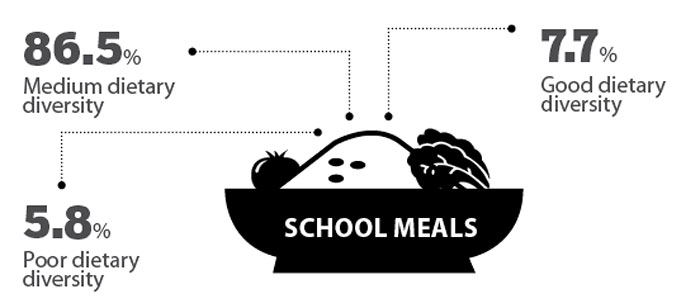Yangchen C Rinzin
More than 24.7 percent of school feeding stipend is spent on roots and tubers like potatoes, 1.2 percent on fish and fish products, 12.6 percent on meat and meat products and only 2.4 percent on fruits.
This was revealed through a study on the expenditure of schools.
Going by the stipend expenditure on food sources, more than 55 percent of vegetables are procured from traders and contractors, which means the majority of vegetables fed to students are imported.
Students receive a stipend of Nu 1,500 per child for three meals for boarders today. The education ministry gives 60 percent of the stipend to the Food Corporation of Bhutan for non-perishable items and 40 percent to schools for perishable items.

Realising the importance of nutrition in school, the education ministry observed the second annual national school nutrition day yesterday.
Observing the day themed ‘Eat for the Health of it’, the ministry and World Food Programme (WFP) launched PLUS school menus tool.
WFP’s programme policy officer, Udaya Sharma, said that it was an algorithm to calculate an optimal menu, crafted to the programme’s needs, and at the minimum cost to prepare healthy meals for students.
He said that with many schools buying tubers and roots for meals, it has not met the required nutrients for children. “So there should be a way to substitute and the PLUS menu can do that.”
He said that the PLUS menu was the first digital solution that optimised school menus by making simultaneously more nutritious, cost-efficient school meals, and that are locally sourced. “PLUS uses a set of database and an advanced mathematical algorithm to set a menu for meals in schools.”
More than 80 percent of Bhutanese do not eat enough vegetables or fruits, according to the STEPS survey 2019. One in two children is anaemic, one in five children stunted, one in three adolescent girls anaemic, and 7.6 percent of children overweight.
Udaya Sharma said that WFP found that more schools (86.5%) provided meals with medium dietary diversity and only 7.7 percent with a good score based on students’ dietary diversity.
Dietary diversity is defined as the number of different foods or food groups consumed.
He added that only 36 percent of stipend was spent on local farmers and cooperatives and four percent from the School Agriculture Programme. “So the PLUS tool can help find food sourcing. While we always hear farmers complaining about lack of market, we see school feeding can be the biggest market.”
He, however, said there were also challenges with many schools not getting varieties of required and diverse vegetables in the locality. “PLUS tool can also help work on this.”
Udaya Sharma claimed that studies have indicated day scholar students have higher rates of overweight and obesity than boarder students. “More day scholar students reported consuming carbonated soft drinks.”
He also said, going by the reports, it was all linked with the lifestyle of Bhutanese. “So, PLUS tool would also provide options to change buying habit.”
Explaining the PLUS tool, Udaya Sharma said that there would be about 3,500 food items available in the PLUS tools inbuilt in the system internationally with its nutrient contents against each food.
He said WFP would then work out the food items list for local content, select the menu, and substitute what is not available. “A separate list for Bhutan will be made available in the PLUS tool system with its nutrient contents.”
Udaya Sharma said that once the listing was done, the school could use the list to make a menu every day based on each dzongkhag with food available in that area. “This means different schools will have different menus according to different age group in different places. Currently, all schools follow the same menu, irrespective of the availability of vegetables in the place.”
He added that the tool was piloted in Punakha Central School, and the result showed that maintaining the same nutritional values of the current menu helped to save 20 percent of the cost. “It also increased the food source from smallholder farmers from 10 percent to 17 percent.”
However, the PLUS tool will be first implemented in Trongsa and Zhemgang this year as a part of the school and hospital feeding programme. It will then be implemented nationwide with a district level school menu from next year.
Emphasising the importance of the role of school health and nutrition interventions in education, WFP Bhutan Country Director Svante Helms, said that, as schools re-opened, school health and nutrition interventions were important because they protected children’s health.
He said it provided powerful incentives for parents to re-enrol children in school and increase retention rates, especially among girls. “A healthy, well-nourished child is a happier child with a much better chance for a brighter future.”
Korean International Cooperation Agency (KOICA) funded the 2nd National School Nutrition Day.

